In this lesson, students will find examples of stories and symbols that represent unity, harmony, or peace on the Senufo Drum. They will then compare the West African symbols to symbols from their own culture.
Students will be able to:
- observe and describe the symbols on the Senufo Drum;
- research symbols found in different cultures and share the information with others; and
- compare and contrast the symbols found in other cultures with the ones on the Drum.
Lesson
- Show students the Senufo Drum and encourage them to ask questions and share observations about what they see. Tell students that each of the carved pictures found on the drum is a symbol; younger children may be unfamiliar with this term, so be sure to provide a definition and examples.
- Show students the symbols on the Drum by sharing the “Details” information from the About the Art section. Spend time explaining the meaning of the two-headed crocodile. This symbol can stand for unity, harmony, or peace. The two crocodiles who shared a stomach had to learn to work together to decide which head got to eat first.
- Read one or two stories from Peace Tales by Margaret Read MacDonald, which is a collection of folktales from around the world designed to help children think about what peace is. Have a class discussion about peace and what it means.
- Next, explain to students they will be learning about other symbols from around the world that stand for unity, harmony, or peace. Ask students to find a symbol either in a book or online and draw it, write down what they symbol means, and try to find out what part of the world it is from. Allow students to work in pairs or small groups. Younger students may simply be given a symbol and asked to draw it and write down the name, while older students can use books and websites to do research. Give these students access to books or bookmarked Internet sites to learn about these symbols. Some resources are:
- When students have completed their task, allow groups to share what they found. Let them show their drawings and information about the symbol they found. Discuss this activity as a class. What did students learn? Did any of the symbols they found look like the ones found on the drum? Why does art often have symbols? Why do they think there are so many symbols on this drum?
Materials
- Books, computers, and Internet access to be used as resources to learn about peace symbols
- Paper and pencils/crayons for students to draw and record information
- Margaret Read MacDonald’s book Peace Tales: World Folktales to Talk About (August House, 2005)
- Other book sources on peace such as Jill Jackson's and Sy Miller's Let There be Peace on earth: And Let it Begin with Me (Tricycle Press, 2009), or Karen Katz's Can You Say Peace? (Henry Holt, 2006)
- Internet access to the following resources about symbols: Wikipedia Peace Symbols, Peace Symbols, Adinkra Index
- About the Art section on the Senufo Drum (included with the lesson plan) or student access to this part of Creativity Resource online
- Color copies of the Drum for students to share, or the ability to project the image onto a wall or screen
Standards
- Visual Arts
- Observe and Learn to Comprehend
- Relate and Connect to Transfer
- Envision and Critique to Reflect
- Language Arts
- Oral Expression and Listening
- Research and Reasoning
- Writing and Composition
- Reading for All Purposes
- Collaboration
- Critical Thinking & Reasoning
- Information Literacy
- Invention
- Self-Direction
Drum
This drum was carved by a Senufo [seh-NOO-foe] artist. The Senufo live in small communities throughout Mali and the Ivory Coast in West Africa. They are known as excellent farmers with a very strong sense of community. Often, the land is worked collectively, with every family contributing to the good of the community. The communities are organized into a caste-like system, with farmers at the top and musicians at the bottom. Carvers, along with other artists like blacksmiths and potters, belong to a special social caste and live apart from the rest of the community. Training to become a carver takes about seven or eight years. Carvers start as apprentices, making secular objects, and must go through a kind of initiation before they can begin to produce ritual objects. The role of an artist is inherited through a mother.
Drums like this are both musical instruments and works of sculpture. The Senufo use music for much more than entertainment. Music is an important part of everyday life and plays a significant role in work, celebrations, healing, and rituals. Drums are used in ceremonial functions like funerals or memorials to summon ancestor spirits. This drum is covered in images that reference proverbs, cultural traditions, ways of behaving, and values that are important to the community. Animals play an important role in the Senufo belief system and ancestor spirits can take the form of any animal. Animals often serve as a source of inspiration for carvers. (Check out the "Details" section for more information on the individual carvings.)
Details
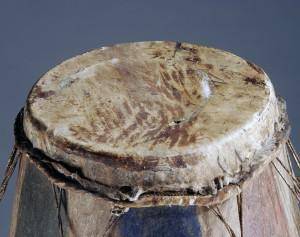
Hide
The top of the drum is covered in hide and tightened with straps. This is what produces the sound.

Python
The python is one of the most common Senufo motifs. He is associated with divination. Bracelets with python imagery are traditionally worn by diviners, who foretell future events and interpret omens.

Crocodile
The Senufo consider the crocodile to be one of the first creatures to inhabit the earth.
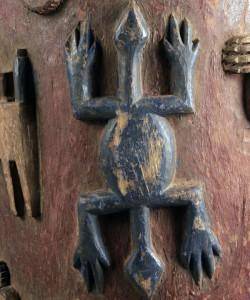
Two-headed Crocodile
The image of the two-headed crocodile refers to an ancient myth from Ghana. The story tells of a crocodile with two heads who would argue over which would eat the food they caught first. One day they finally recognized their need to share.
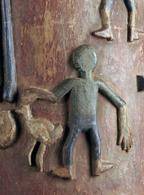
Chicken
Senufo diviners advise farmers to sacrifice chickens and communicate with spirits in the fields. This drum shows a figure with a bird and possibly a sacrificial bowl.
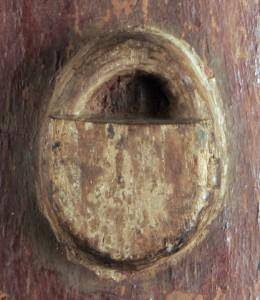
Padlock
The padlock is usually a statement about power and control. Locks are standard devices imported from the north.
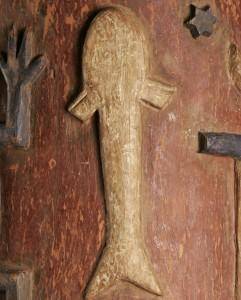
Fish
Some fish are sacred and not to be eaten. Certain fish represent wealth and happiness.
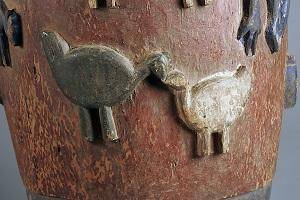
Hornbill Bird
The hornbill was the mythological founder of the Senufo people and is considered a noble bird. Hornbills mate for life and share equally in the raising of their young, whom they protect by spreading their wings.

Sankofa Bird
These birds are usually shown with their heads turned back. They represent the message “pick it up if it falls behind,” which means if you have forgotten something, you can return to retrieve it; or that mistakes can be corrected; or that one must look back to the past to make good decisions for the present and future.

Blacksmith
The blacksmith is shown with a hammer, anvil, and bellow. The blacksmith was viewed as an artisan with magical connections to fire and transformation.
Funding for object education resources provided by a grant from the Morgridge Family Foundation. Additional funding provided by the William Randolph Hearst Endowment for Education Programs, and Xcel Energy Foundation. We thank our colleagues at the University of Denver Morgridge College of Education.
The images on this page are intended for classroom use only and may not be reproduced for other reasons without the permission of the Denver Art Museum. This object may not currently be on display at the museum.







